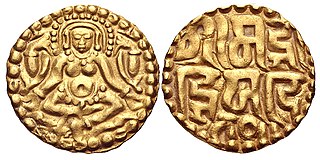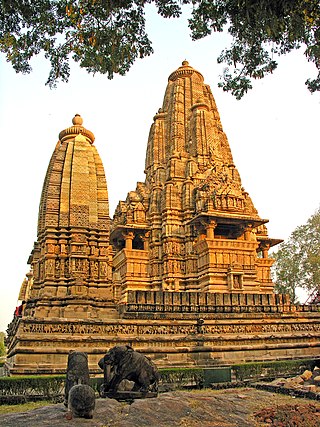Related Research Articles

The Chandelas of Jejakabhukti was an Indian dynasty in Central India. The Chandelas ruled much of the Bundelkhand region between the 9th and the 13th centuries. They belonged to the Chandel clan of the Rajputs.
Vidyadhara was a Chandela king of central India. He ruled in the Jejakabhukti region. Vidyadhara was the successor of Ganda, and expanded the Chandela power between Chambal river in the northwest and Narmada River in south.
Ganda was an early 11th century king of the Chandela dynasty of India. He ruled in the Jejakabhukti region. The exact period of his reign is uncertain, but has been dated approximately as 999-1002 CE.
Dhanga, also known as Dhaṇgadeva in inscriptions, was a king of the Chandela dynasty of India. He ruled in the Jejakabhukti region. Dhanga established the sovereignty of the Chandelas, who had served as vassals to the Pratiharas until his reign. He is also notable for having commissioned magnificent temples at Khajuraho, including the Vishvanatha temple.
Hammira-Varman was a king of the Chandela dynasty of central India. He ruled in the Jejakabhukti region. During his reign, the Delhi Sultan Alauddin Khalji conquered some parts of the Chandela kingdom.
Rahila was a king of the Chandela dynasty of India. He ruled in the Jejakabhukti region.

The Kalachuris of Tripuri, also known the Kalachuris of Chedi, ruled parts of central India during 7th to 13th centuries. They are also known as the Later Kalachuris to distinguish them from their earlier namesakes, especially the Kalachuris of Mahishmati. Their core territory included the historical Chedi region, and their capital was located at Tripuri.
Harsha, also known as Shri Harsha, was a king of the Chandela dynasty of India. He ruled in the Jejakabhukti region.

Yashovarman, also known as Lakshavarman, was a king of the Chandela dynasty of India. He ruled in the Jejakabhukti region. He practically established the Chandelas as a sovereign power, although he formally acknowledged suzerainty of the Gurjara-Pratiharas. His major military achievement was the conquest of Kalanjara. He is also notable for having commissioned the Lakshmana Temple at Khajuraho.
Vijayapala was a king of the Chandela dynasty of India. He ruled in the Jejakabhukti region.
Kirttivarman, also known as Kīrtivarman, was a king of the Chandela dynasty of India. He ruled the Jejakabhukti region. He revived the Chandela power by defeating the Kalachuri king Lakshmi-Karna.

Sallakshana-Varman was a king of the Chandela dynasty of India. He succeeded his father Kirttivarman as the ruler of the Jejakabhukti region. The inscriptions of his descendants suggest that he achieved military successes against the Paramaras, the Kalachuris of Tripuri and the ruler of Kanyakubja.
Prithvi-Varman was a king of the Chandela dynasty of India. He succeeded his nephew Jayavarman as the ruler of the Jejakabhukti region.

Madana-Varman was a king of the Chandela dynasty of India. He succeeded his father Prithvi-Varman as the ruler of the Jejakabhukti region. He revived the Chandela glory by subduing the neighbouring kingdoms, and commissioned several tanks and temples.
Paramardi was a king of the Chandela dynasty of central India. He was the last powerful Chandela king, and ruled the Jejakabhukti region. Around 1182–83 CE, he was defeated by Prithviraj Chauhan, who raided the Chandela capital Mahoba. Paramardi managed to recover the Chandela power over the next few years, but was defeated by the Ghurid general Qutb ud-Din Aibak around 1202–03 CE.
Trailokya-Varman was a king of the Chandela dynasty of central India. He ruled the Jejakabhukti region. Epigraphic evidence suggests that he recaptured Kalanjara from the Delhi Sultanate.
Vira-Varman was a king of the Chandela dynasty of central India. He ruled the Jejakabhukti region.
The Yajvapala dynasty ruled parts of central India during the 13th century CE. Their capital was located at Nalapura. They are also known as Jajapella or Jajpella. The Yajvapalas carved out a kingdom in northern Madhya Pradesh during the first half of the 13th century, and successfully resisted invasions by the Chandelas and the Delhi Sultanate over the next few decades. It is not certain how their rule ended, but they probably fell to the Delhi Sultanate by the end of the century.
Lakshmikarna, also known as Karna, was a ruler of the Kalachuri dynasty of Tripuri in central India. His kingdom was centered around the Chedi or Dahala region in present-day Madhya Pradesh.
Gayakarna was a ruler of the Kalachuri dynasty of Tripuri in central India. His kingdom was centered around the Chedi or Dahala region in present-day Madhya Pradesh.
References
- ↑ Sisirkumar Mitra 1977, p. 90.
- ↑ R. K. Dikshit 1976, p. 102.
- ↑ Sisirkumar Mitra 1977, p. 93.
- 1 2 Sisirkumar Mitra 1977, p. 91.
Bibliography
- R. K. Dikshit (1976). The Candellas of Jejākabhukti. Abhinav. ISBN 9788170170464.
- Sisirkumar Mitra (1977). The Early Rulers of Khajurāho. Motilal Banarsidass. ISBN 9788120819979.